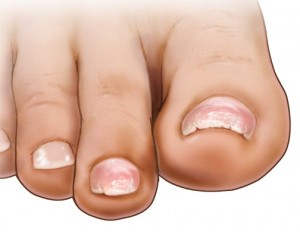If you suffer from brittle nails, you’re not alone. Experts believe that up to 20 percent of the US population suffers from onychorrhexis (the medical term for brittle toenails or fingernails).
Brittle nails can cause considerable misery for people who suffer from them; the split ends that look like they’ve been gnawed by a hungry animal are bad enough, but the ridges are the icing on a very unattractive cake.
Women who try to grow their nails to any length generally find that the nail breaks—unevenly—as soon as it gets more than a millimeter past the end of the toe or finger.
While weakness of the nails can take many forms—split nails, crumbling nails, etc. —the term onychorrhexis refers to a specific condition that is characterized by splitting and by the formation of longitudinal (lengthwise) ridges on the surface of the nail.
This condition can have many causes, and in some cases, doctors are unable to determine the exact reason for a patient’s brittle toenails, and must settle for diagnosing the condition as idiopathic—medical jargon for “who knows?”

Why Are My Toenails Brittle?
Brittle, easily broken toenails have a variety of possible causes. There is often not one single cause, but rather a number of factors working together. Possible causes of onychorrhexis include:
- Hypothyroidism: Along with weight gain and fatigue, brittle nails and hair are among the more notable symptoms of an underperforming thyroid gland.
- Vitamin deficiencies and other nutritional problems can cause onychorrhexis, as can eating- and nutrition-related disorders such as bulimia, anorexia, and anemia.
- Overuse of chemical products: Women who paint their toenails and change colors too often can acquire brittle nails. Ironically, one of the most susceptible professions is nail salon work; the polish removers and cuticle solvents that nail salon workers are exposed to throughout their workdays can easily contribute to onychorrhexis of the fingernails.
- Excessive exposure to strong soap, such as may result from certain occupations (e.g., dishwashing), can cause brittle fingernails. Compulsive washing of the hands or feet can also contribute to brittle nails.
- Age: As we get older, our bodies become less able to retain moisture, which eventually causes our hair and nails to become brittle and easily damaged.
- Toenail fungus can weaken your nails, causing them to split or crumble.
- Raynaud’s Phenomenon is a poorly understood medical condition in which blood flow to the toes and fingertips is too easily hindered by the subject’s extreme sensitivity to cold. This can cause the toenails to be deprived of sufficient oxygen, making them brittle.
- Psoriasis, eczema, and other skin conditions can also attack the nails, making them weak and brittle.
One frustrating aspect of the brittle nail problem is that it can be the result of too little moisture—or too much. Swimming coaches, lifeguards, and others who spend a lot of time in the water often report brittle nails, which are often directly attributable to their occupations.
On the other hand, the damage that occurs to the fingernails of someone who works with chemicals all day is generally caused by dehydration of the nail.
Also, as noted above, the reason our nails become increasingly fragile and brittle as we get older is that our bodies lose some of their ability to retain moisture as we age.
How Are Brittle Nails Treated?
The B complex vitamin biotin has been demonstrated to strengthen weak, brittle nails. Over-the-counter biotin supplements such as Appearex can be found in most chain drugstores. Studies appear to show that 2.5 milligrams of biotin daily will improve nail strength.
Since a nail takes about six months to replace itself, it may take at least that long for the benefits of biotin supplements to become apparent, but 25–30 percent of people who try biotin see improvement within four to six months.
Another product that shows promise in the treatment of brittle nails is Genadur. Unlike biotin supplements, Genadur is available only with a prescription.
The significance of this product is that it is the first treatment for fragile, brittle nails that has been approved by the FDA.
According to Genadur’s manufacturer, Medimetriks Pharmaceuticals, a once-daily brush-on application may produce results within two or three weeks.
Unproven Treatments for Brittle Toenails You Should Know About
The following products and supplements have all been touted at one time or another, and they all have one thing in common: none of them have ever been clinically proved to work.
- Silicon
- Horsetail (an herbal supplement)
- Calcium supplements
- Iron
- Vitamin A
- Cysteine
- Zinc
That’s not to say for sure that none of the items on this list will help, but the studies that have been conducted to date have been inadequate, and in some cases have been funded by companies involved in marketing them as miracle cures for brittle nails. When more research is needed, the consumer should always be skeptical.
Talking to Your Doctor About Brittle Nails
Here are some questions to ask your doctor if you suffer from brittle toenails:
- What is causing my brittle toenails?
- Will biotin supplements help strengthen my nails?
- What is meant by the term onychorrhexis?
- Can you tell me more about Genadur?
- Are my eating habits to blame for this condition? Do I suffer from a vitamin deficiency?
- Is it possible my brittle toenails are a sign of some more serious underlying condition?




